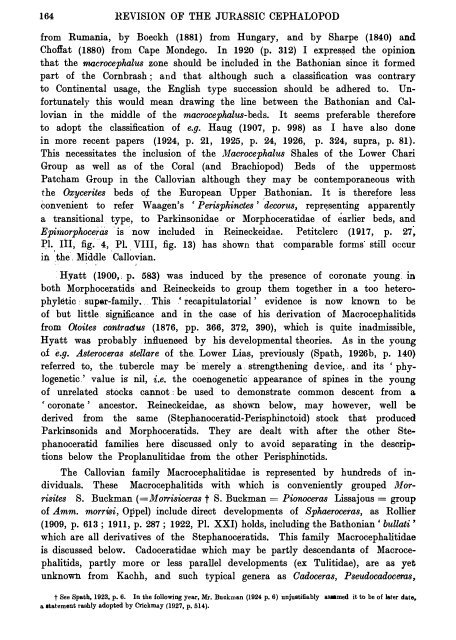ialontolngia ndita,
ialontolngia ndita,
ialontolngia ndita,
You also want an ePaper? Increase the reach of your titles
YUMPU automatically turns print PDFs into web optimized ePapers that Google loves.
164 REVISION OF THE JURASSIC CEPHALOPOD<br />
from Rumania, by Boeckh (1881) from Hungary, and by Sharpe (1840) and<br />
Cho:ffat (1880) from Cape Mondego. In 1920 (p. 312) I expressed the opinion<br />
that the macrocephalus zone should be included in the Bathonian since it formed<br />
part of the Cornbrash; and that although such a classification was contrary<br />
to Continental usage, the English type succession should be adhered to. Unfortunately<br />
this would mean drawing the line between the Bathonian and Callovian<br />
in the middle of the macrocephalus-beds. It seems preferable therefore<br />
to adopt the classification of e.g. Haug (1907, p. 998) as I have also done<br />
in more recent papers (1924, p. 21, 1925, p. 24, 1926, p. 324, supra, p. 81).<br />
This necessitates the inclusion of the Macrocephalus Shales of the Lower Chari<br />
Group as well as of the Coral (and Brachiopod) Beds of the uppermost<br />
Patcham Group in the Callovian although they may be contemporaneous with<br />
the Oxycerites beds ot the European Upper <br />
Bathonian.<br />
It is therefore less<br />
convenient to refer Waagen's 'Perisphinctes ' decorus, reprsenting apparently<br />
a transitional type, to Parkinsonidae or Morphoceratidae of arlier beds, and<br />
Epimorphoceias ·is now included in · Reineckeidae. · Petitclerc (1917, p. 27,<br />
1.. Ill, fig . .. 4, .<br />
PI.. VIII, fig. 13) has shown that comparable forms still occur<br />
in .the . Middle Callovian.<br />
· Hyatt (1900,, p. 583) was induced by the presence of coronate young in<br />
both Morphoceratids and Reineckeids to group them together in a too heterophyletic:<br />
sup9r-family .. This .' recapitulatorial' evidence is now known to be<br />
of but little significance and in the case of his derivation of Macrocephalitids<br />
from Otoites CO!l/,tractus (1876, pp. 366, 372, 390), which is quite inadmissible,<br />
Hyatt was probably .influenced by his developmental theories.<br />
As in the young<br />
of e.g. Asteroceras stellare of .the. Lower Lias, previously (Spath, 1926b, p. 140)<br />
referred to, the. tubercle may .be· merely a, strengthening device,. and its 'phylogenetic.'<br />
value is nil, i.e. the coeiwgenetic· appearance of spines in the young<br />
of unrelated stocks cannot.: be used to demonstrate common descent from a<br />
'coronate ' ancestor. Reineckeidae, as shown below, may however, well be<br />
derived from the same (Stephanoceratid-Perisphinctoid) stock that produced<br />
Parkinsonids and Morphoceratids. They are dealt with after the other Stephanoceratid<br />
families here discussed only to avoid separating in the descrip-;<br />
tions below the Proplanulitidae from the other Perisphinctids.<br />
The Callovian family Macrocephalitidae is represented by hundreds of individuals.<br />
These Macrocephalitids with which is conveniently grouped .Morrisites<br />
S. Buckman (=Morrisiceras t S. Buckman = Pionoceras Lissajous = group<br />
of Amm. morrisi, Oppel) include direct developments of Sphaeroceras, as Rollier<br />
(1909, p. 613 ; 1911, p. 287 ; 1922, Pl. XXI) holds, including the Bathonian ' bullati '<br />
which are all derivatives of the Stephanoceratids. This family Macrocephalitidae<br />
is discussed below. Cadoceratidae which may be partly descendants of Macrocephalitids,<br />
partly more or less parallel developments (ex Tulitidae), are as yet<br />
unknown from Kachh, and such typical genera as Oadoceras, Pseudocadocas,<br />
t See Spa.th, 1923, p. 6.<br />
a lta.tement rashly adopted by Crickmay (1927, p. 514).<br />
In the following y£>ar, Mr. Buckman (1924 p. 6) unjustifiably asamed it to be of later date,
















